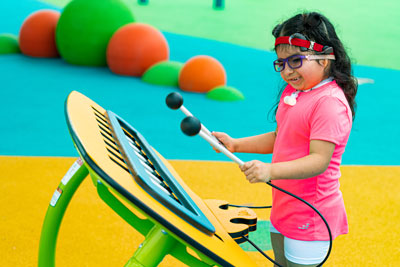Kids don’t love staying in one spot. Anyone who has been around children will think that’s an obvious statement, but this is a lesson I learned in preschool. Born with Spina Bifida, a birth defect in which my spinal column didn’t close properly, I was moving very differently than my able-bodied peers. I used a walker and crutches at the time and found myself moving slowly and getting tired much quicker. This meant when it was time for recess, the day’s highlight for many, I dreaded it.
My friends would sit with me for a few minutes, but inevitably they’d begin to run around to play games, challenge themselves on climbers, go up the steep stairs to the slides and do what kids are supposed to do at recess: play. It never occurred to me, my family or the school that this could be different because at the time, playgrounds weren’t spoken about in a way that welcomed children with disabilities. At the time, the medical model of disability, which focused on modifying my abilities and me rather than adapting the surrounding environment, was most prevalent.
Thanks to the work of inclusive-play advocates and greater use of inclusive design practices, playgrounds are evolving to better meet the needs of the greater disabled community. In 2024, we are evolving to the social model of disability, which emphasizes that individuals do not require “fixing”—they are not the problem. Instead, it’s the built environment that needs to be adapted and changed.

Inclusion goes so much further than simply adding a ramped structure. Inclusive design has begun to explore how to integrate diverse sensory experiences for children with autism and sensory disabilities. This includes activities like swinging, spinning and motion play that engage the vestibular sense or proprioceptive activities such as climbing, which activates muscles and joints. Inclusive design provides something for everyone to find their just-right fit, to keep them engaged and comfortable at play for as long as possible. Children can get overwhelmed at the playground, and we’ve learned that incorporating a cozy quiet space into a playground design allows them to calm themselves and re-engage in play when they’re ready. Having both choice and a voice in how you play and experience a space is an incredibly empowering experience.
Today’s playground developers are focused on creating meaningful activities that engage the sensory systems of children of all abilities. This includes providing activities for blind/low vision and deaf/hard-of-hearing users who haven’t always been considered at the play space. Sound and musical play provides a rich, tactile vibration experience, but it also helps provide auditory cues for people with visual disabilities, which helps them stay oriented in a space. Incorporating color, contrast and tactile cues enhances sensory awareness for everyone experiencing a space, seamlessly blending these elements not as “special accommodations” for disabled individuals, but as integral features to support all visitors.
Play and communities have evolved, acknowledging the valuable contributions of individuals with disabilities. New and forthcoming inclusive design celebrates this, ensuring that everyone who enters a park and play environment feels welcomed and valued. For instance, you may notice greater use of color and contrast at playgrounds. This can help children better perceive and differentiate playground features. Steps on the playground may use color cues. This can help kids spot changes in elevation and know how far they need to climb. A balance beam may contrast in color with the ground below. This can inspire a kid with limited depth perception to see it and walk it. Sound elements like musical play panels or outdoor musical instruments help alert users to where they are. And elements like colored walkways, ground texture changes and guide ropes can help them get around. Increasingly, communities across the U.S. are exhibiting a greater understanding of (and appreciation for) play. Play, a cornerstone of childhood, is a lifelong journey that builds skills and forges friendships. Play is way too valuable to tell anyone they must stay in one spot. Play is meant to be celebrated everywhere we go.
Over the past years, some incredible projects have come to life, and I increasingly work with or hear from communities committed to creating inclusion. From city planners and city councils to landscape architects and surveyors, more and more groups are getting involved in playground and park design and development. It’s an exciting change to see diverse community groups come together with a goal of creating inclusive spaces for all of a town’s residents. These groups are thinking about who will use a playground and what inclusion means for them. They’re seeking local ability demographics to help them understand their local disabled community so a playground can be designed to their community’s unique needs.
From concept to ribbon-cutting, creating these spaces are labors of love and respect. In its completion, Park Circle Playground in North Charleston, S.C., is the largest inclusive playground in the world. This project took more than six years to complete as they created their vision. They engaged and amplified the voices of the disability community throughout their town, ensuring that their needs were not only heard but actively incorporated. The result is a true community achievement that features accessible baseball fields, a new community center, and a 55,000-square-foot inclusive playground. Inclusive design was at the forefront in each step of the project. Park Circle Playground is a visual statement of the community’s value for every ability. Park design and development is once again crossing a new threshold. From the medical model to the social model, playground and park design and development is now involving entire communities. This trend will be the new norm as communities openly embrace the beauty, value and benefits of inclusive spaces. RM
ABOUT THE AUTHOR
Jill Moore is inclusive play specialist for Landscape Structures. For more information, visit www.playlsi.com.



